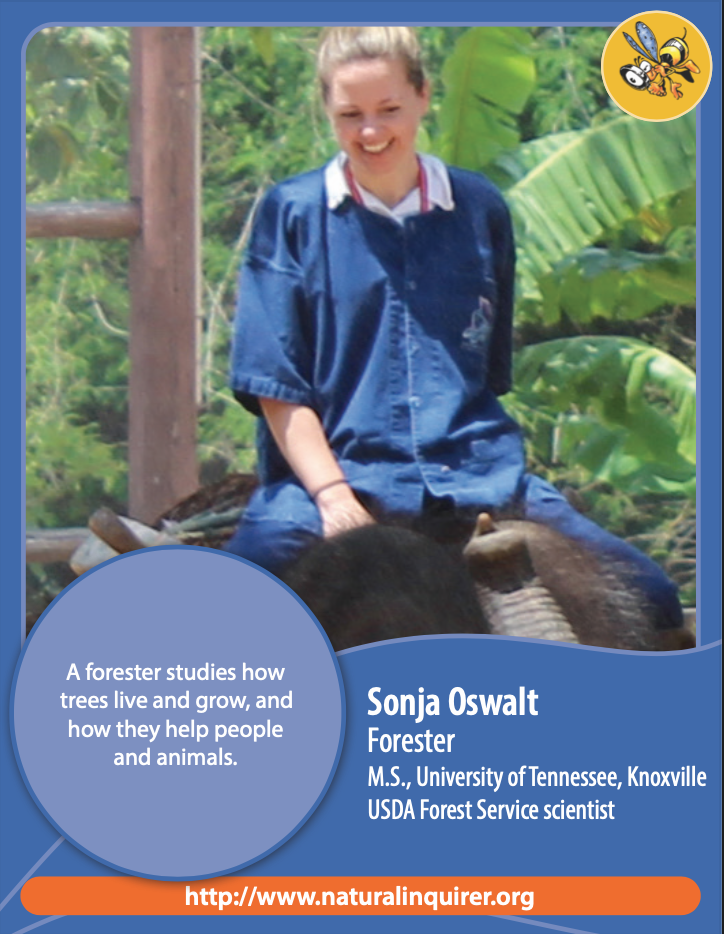Welcome to our website’s resource library, where we offer an extensive collection of free science materials tailored for K-12 students. Dive into a wealth of educational resources including articles, activities, lesson plans, learning modules, and much more. All materials are free to download!
-

 Forests & PlantsWildlife
Forests & PlantsWildlifeMatthew P. Peters, Ecologist

- M.S., Arizona State University
- USDA Forest Service Scientist
- Ecology is the study of the relationships between organisms and their physical surroundings. As an ecologist, I use my background in geography to examine spatial patterns in ecology.
- M.S., Arizona State University
- USDA Forest Service Scientist
- Ecology is the study of the relationships between organisms and their physical surroundings. As an ecologist, I use my background in geography to examine spatial patterns in ecology.
-

 Forests & Plants
Forests & PlantsDavid Peter, Plant Ecologist

- Ph.D., University of Wisconsin
- USDA Forest Service Scientist
- A plant ecologist studies the way plants interact with their environment or with other organisms, including other plants.
- Ph.D., University of Wisconsin
- USDA Forest Service Scientist
- A plant ecologist studies the way plants interact with their environment or with other organisms, including other plants.
-

 Forests & PlantsWildlife
Forests & PlantsWildlifeKristen A. Pelz, Ecologist

- Ph.D., Colorado State University
- USDA Forest Service Scientist
- Ecology is the study of how organisms interact with each other and their environment. I am a plant ecologist.
- Ph.D., Colorado State University
- USDA Forest Service Scientist
- Ecology is the study of how organisms interact with each other and their environment. I am a plant ecologist.
-

 Forests & Plants
Forests & PlantsJohn Parrotta, Forest Restoration Ecologist

- Ph.D., Yale University
- USDA Forest Service Scientist
- A forest restoration ecologist uses knowledge of forest ecology to develop techniques that restore the biodiversity, structure, and function of forests that have been degraded by human activities.
- Ph.D., Yale University
- USDA Forest Service Scientist
- A forest restoration ecologist uses knowledge of forest ecology to develop techniques that restore the biodiversity, structure, and function of forests that have been degraded by human activities.
-

 Forests & Plants
Forests & PlantsSonja Oswalt, Forester

- M.S., University of Tennessee, Knoxville
- USDA Forest Service Scientist
- A forester studies how trees live and grow, and how they help people and animals.
- M.S., University of Tennessee, Knoxville
- USDA Forest Service Scientist
- A forester studies how trees live and grow, and how they help people and animals.
-

 Forests & Plants
Forests & PlantsChristopher Oswalt, Forest Ecologist & Silviculturist

- Ph.D., University of Tennessee
- USDA Forest Service Scientist
- As a forest ecologist and silviculturist, I study patterns among the diverse processes and plants within forest ecosystems, as well as the impact of humans on those ecosystems. I also find interesting ways to share forest-related information with others.
- Ph.D., University of Tennessee
- USDA Forest Service Scientist
- As a forest ecologist and silviculturist, I study patterns among the diverse processes and plants within forest ecosystems, as well as the impact of humans on those ecosystems. I also find interesting ways to share forest-related information with others.
-

 Forests & PlantsWildlife
Forests & PlantsWildlifeMalcolm North, Forest Ecologist

- Ph.D., University of Washington
- USDA Forest Service Scientist
- A forest ecologist studies the structure, composition, and processes that interact in a forest to provide different habitats for plants and animals.
- Ph.D., University of Washington
- USDA Forest Service Scientist
- A forest ecologist studies the structure, composition, and processes that interact in a forest to provide different habitats for plants and animals.
-

 Forests & Plants
Forests & PlantsSteve Norman, Forest Ecologist

- Ph.D., Penn State University
- USDA Forest Service Scientist
- A forest ecologist studies forest changes to understand what it means for forest values like clean air and water, wood products, wildlife habitat, and recreation.
- Ph.D., Penn State University
- USDA Forest Service Scientist
- A forest ecologist studies forest changes to understand what it means for forest values like clean air and water, wood products, wildlife habitat, and recreation.
-

 Forests & Plants
Forests & PlantsIsabel Alvarez Munck, Plant Pathologist

- Ph.D., University of Wisconsin-Madison
- USDA Forest Service Scientist
- Plant pathologists study plant diseases. A plant disease is the interaction between plants, their pathogens (viruses, bacteria, nematodes, and fungi), and the environment.
- Ph.D., University of Wisconsin-Madison
- USDA Forest Service Scientist
- Plant pathologists study plant diseases. A plant disease is the interaction between plants, their pathogens (viruses, bacteria, nematodes, and fungi), and the environment.
-
 In this FACTivity, you will build a physical representation, or a model, of a beaver dam. Some of the questions…In this FACTivity, you will build a physical representation, or a model, of a beaver dam. Some of the questions you will answer in this FACTivity are: How can you...
In this FACTivity, you will build a physical representation, or a model, of a beaver dam. Some of the questions…In this FACTivity, you will build a physical representation, or a model, of a beaver dam. Some of the questions you will answer in this FACTivity are: How can you...




